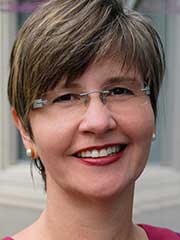Dayana Salazar
Professor, Urban and Regional Planning
dayana.salazar@sjsu.edu
408-924-5441
What research questions currently preoccupy you?
I am interested in effective ways to measure the impact of complex multi-sector, interdisciplinary efforts aimed to improve the quality of life in urban neighborhoods. After 2-3 decades of development in this area, the only consensus in the field is that we need to continue working harder to provide evidence of the effectiveness of community development interventions.
What personal factors contributed to your study of urban planning and community development?
Ever since I remember I’ve been wondering what draws us to stay in and enjoy places, primarily urban, public spaces. I grew up in Colombia, a country with a strong urban culture where urban spaces can be either lively and vibrant, or foreboding. I then set out to learn more about the factors behind the interaction between the physical environment and human behavior.
What has been most challenging in your work in community development?
Meaningful community change takes a great deal of collective effort and time. While it is important to set a compelling shared vision, is even more important to make sure that there is a strong commitment to realizing that vision, even if it takes decades. I have worked over the past 25 years in community development projects with our students within the time frame of the academic semester or year, or even within the span of their careers at SJSU. This can result in somewhat anticlimactic moments when high impact community projects or initiatives come to fruition long after those students who planted and tended the seeds for change have moved on.
How has your position in SJSU contributed to your work in community development?
SJSU offers endless opportunities to engage our students and faculty colleagues in partnerships with communities surrounding our campus, and beyond. The work of community change is interdisciplinary at its core, and our campus offers a rich field of potential partners to play in this field. I have found it very rewarding to collaborate with faculty colleague who work with their students as consultant and/or research teams for the benefit of our local communities.
A hidden talent?
I started my professional life as an architect. This training and practice helped me develop a fairly strong understanding of three-dimensional space and the ability to represent it—which even though I don’t use much formally I still maintain.
One book that changed your understanding of cities and why?
I was drawn to think of some cities and spaces as having an almost magical quality by Italo Calvino’s book Invisible Cities. The book made me think about places as each having its own unique character, and how our interaction with places is constantly adapting and changing them, and vice versa: the places where we live or visit also become part of us. We change each other.
Advice you’d give to newer faculty or students?
We are in one of the most dynamic urban regions of the world, and this location offers endless opportunities to participate in the endless process of change happening all around us. All we need to do is reach out and state that we’d like to participate in shaping what our region will be like in the next year, or 20, or 50 years. That willingness is bound to be welcomed enthusiastically. Just do it.
